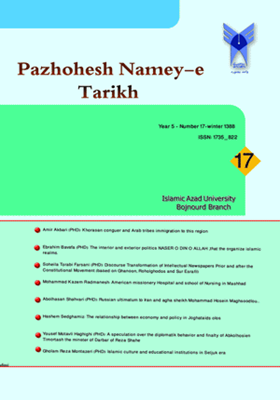Islamic culture and educational institutions in Seljuk era
Subject Areas : Epistemological and methodological researcher of historical research
1 - استادیار فرهنگ و تمدن اسلامی
دانشگاه علوم کشاورزی و منابع طبیعی گرگان
Keywords: Seljuks, Islamic Culture, Educational institutions,
Abstract :
Toghrol Beik established a huge Empire with his succor and ambition in 429-455 AH. Then, his descendants; i.e. Alp Arsalan (495-566 AH) and Malekshah Saljuki (485-495 AH) have prevailed the peace and security on their social and political dominion, with the help of their tactful and famouse minister's experiences – Khaaje Nezamolmolk Tousi- and then have reached the power and greatness of the Empire to the highest point. The learning spirits of rulers and their interest to build the welfare institutions, mosques, carvanserais, libraries, academic homes, hospitals, school houses; good management and competency of Iranian cultured ministers – particularly Khaaje Nezamol molk Toosi (485 AH)- provided a new chapter in the history of Islamic culture, especially the formation of scientific centers and schools that distinguish this age from previous periods so this age called: '' The Establishment Of School Movement ''. The movement that began in Baghdad with establishing the first Nezamieh school(459AH) and it wasn't long before its results and effects involved the social and political realm of the Abbasian Caliphate and Islamic east; during the cultural exchange, it turned to the model and example for scientific centers and ancient universities of Europe. Besides school ,other educational institutions such as: mosques, libraries, scholars' homes, hospitals, school houses have played an effective role in Islamic culture; developing and expanding of science and technology and training the scholars and scientists that this article attempt to introduce these institutions and cultural outstanding personage in this age as a brief.


